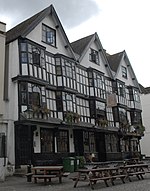Granary, Bristol

The Granary, also known as Wait and James' Granary, is a building on Welsh Back in the English city of Bristol. It was designed by Archibald Ponton and William Venn Gough in red Cattybrook brick, with black and white brick and limestone dressings. It is probably the best preserved example of the Bristol Byzantine style and is designated by English Heritage as a grade II* listed building.The building was built in 1869 as a granary for Wait, James and Co. It was used to dry large quantities of grain, so it had to be strong, stable and warm, with good ventilation. Between 1968 and 1988, it housed a nightclub, also known as The Granary. In 2002, the building was converted into apartments, after the owners, Bristol City Council, had invited competitive bids from developers for its renovation and conversion. Barton Willmore produced the designs which supported the winning bid.
Excerpt from the Wikipedia article Granary, Bristol (License: CC BY-SA 3.0, Authors, Images).Granary, Bristol
Welsh Back, Bristol City Centre
Geographical coordinates (GPS) Address Nearby Places Show on map
Geographical coordinates (GPS)
| Latitude | Longitude |
|---|---|
| N 51.4521 ° | E -2.5926 ° |
Address
Welsh Back
BS1 4RR Bristol, City Centre
England, United Kingdom
Open on Google Maps











